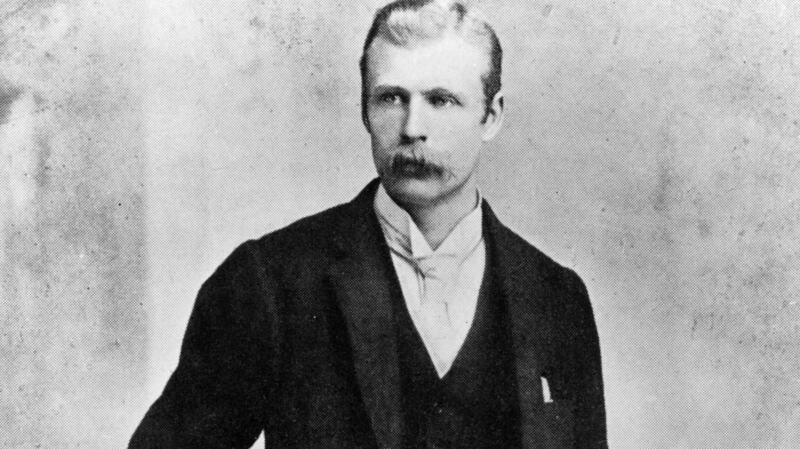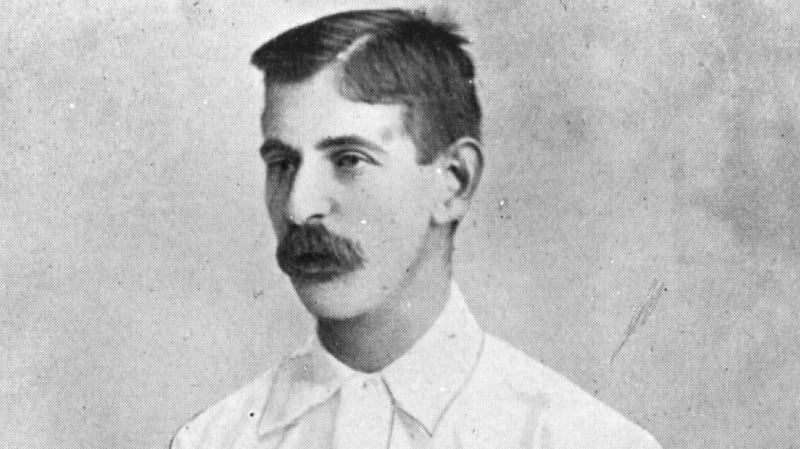For one glorious summer in 1890, the Wimbledon Lawn Tennis championships belonged to Ireland, the country providing the winner of the men's singles, Willoughby Hamilton, women's singles, Lena Rice, and the men's doubles, Joshua Pim and Frank Stoker, thereby completing a clean sweep of the silverware. The women's doubles and mixed doubles tournaments were first played at the All England club in 1913.
Over a seven-year period Irish tennis players won five Wimbledon singles, Hamilton (1890), Pim (1893, 1894), Harold Segersen Mahony (1896) – he was born in Edinburgh to Irish parents but lived and died in Kerry – and Rice (1890) and two men’s doubles titles, Pim and Stoker (1890, 1893); blue riband achievements in what was indisputably the finest decade for Irish tennis and one that will, in all probability, never be emulated.
Another Irishwoman, Ballyragget born, Mabel Cahill, won two US Open singles titles (1891, 1892), two women’s doubles titles (1891, 1892) and the first ever mixed doubles championship in 1892 in a fleeting tennis career with which she quickly appeared to be bored. She is the only Irish person to be inducted into the International Tennis Hall of Fame, an honour bestowed posthumously in 1976.
Willoughby James Hamilton was born on December 9th, 1864 in Monasterevin, one of nine children of the Reverend Canon William Alfred Hamilton and Henrietta, nee Cole. The family moved to the South Dublin parish of Taney in Dundrum, three years later.
According to Mark Ryan’s excellent article on Hamilton, the future Wimbledon champion was educated at Loughborough Grammar School in Leicestershire where his prowess on the playing fields was evident in captaining the school cricket and soccer teams – he played for Ireland against Wales in soccer in 1885 – as well as winning the tennis championships three years running.
The Hamilton family’s sporting genes were not confined to Willoughby, as his brothers William (soccer and cricket), Francis (cricket) and Blayney (cricket and badminton) represented their country across multiple sports.
It has come contrary to universal expectation while they were in the prime of their matured skill and vigour as yet unimpaired
A harbinger of Willoughby Hamilton’s future tennis success can be gleaned from his exploits in winning the 1889 Irish championships at Fitzwilliam – the tournament attracted past, current and future Wimbledon winners in both men’s and ladies’ singles – in which he beat England’s Renshaw twins, William, a seven time Wimbledon singles champion, and Ernest, who also won that title at the All England club.
Pastime, a leading magazine of the time, wrote: “It would be difficult to convey to anybody unfamiliar with the game what is meant by the defeat of the Renshaw brothers at Dublin. There must have come sooner or later a day when the brothers would succumb to a younger antagonist.
“It has come contrary to universal expectation while they were in the prime of their matured skill and vigour as yet unimpaired. This makes for the glory of the victor who has shown himself to be a player of the first rank.”
The Irish Times report was no less effusive: “The title of Champion of Ireland has been held by Englishmen uninterruptedly for the last ten years though many a plucky effort has been made on the part of our Irish players for the proud title which makes Mr Willoughby J. Hamilton’s victory on Saturday all the more meritorious, and which is again welcomed by the unprecedented fact that he beat the two Renshaws in the same tournament, the one by three sets to one and the other by three sets to love.
“Much has been said about the superiority of the Renshaws’ play, but the broad fact remains that Hamilton beat William Renshaw on Friday and Ernest Renshaw on Saturday!”

Hamilton, who had graduated from Trinity and was a stockbroker, also claimed the mixed doubles title, partnering Rice; coincidentally a little over a year later they would both become Wimbledon singles champions. Noted for his dashing style, it served as a marked contrast to his appearance off court, his pale almost translucent complexion earning him the sobriquet, ‘Ghost’ Hamilton.
He travelled to Wimbledon that summer as arguably the best player in the world according to various judges, borne out by victories in several other tournaments, but he lost a five-set semi-final to the unheralded Harry Barlow.
Although he failed to retain his Irish title in 1890 – in those days at both Fitzwilliam and Wimbledon the defending champion only had to play one match, against the winner of the ‘All-Comers final in what was called the ‘Challenge match’ – he cut a swathe through the draw beating future Wimbledon singles champions, Arthur Gore, Wilfred Baddeley and fellow Irishman Pim.
In the All-Comers final he got revenge for his semi-final defeat the previous year by beating Barlow in another titanic, five-set tussle and in the Challenge match squared up to the defending champion, William Renshaw. Despite trailing by two sets to one, he won nine games in a row, his dominance reflected in claiming the final two sets, 6-1, 6-1.
At 25 years of age, Hamilton seemed destined for a storied tennis career but he didn’t defend his title the following year and disappeared from the sport without a trace. Several sources suggest that an illness, blood poisoning, was responsible but he is reputed to have played soccer and cricket subsequently. He might simply have had enough of tennis; the Ghost vanished. He died, aged 78, in 1943.
While there were 30 entries in the men’s singles, there were just four in the women’s singles that year, down a couple on the 1889 tournament and the smallest on record, the latter championship one that Tipperary’s Helena Bertha Grace Rice, known as Lena, might have won. As it transpired she didn’t but atoned the following year.
She was one of eight children, born to Spring and Anna (nee Gorde) Rice, on June 21st, 1866 at Marlhill, a two-storey over basement Georgian house a half a mile outside New Inn in Tipperary. Her father died when she was just two years old, but surrounded by her siblings appears to have enjoyed a happy childhood including time spent playing at Cahir tennis club, usually in the company of sister, Annie, who also competed at Wimbledon.
The first championship in which she played outside of Tipperary was the 1889 Irish Open at Fitzwilliam, where she reached the semi-final only to go down in straight sets to Blanche Bingley Hillyard, a six-time Wimbledon singles winner. A few weeks later the pair met again at the All England club in the All Comers Final, which decided the title in the absence of defending champion Lottie Dod.
Rice led 6-4, 5-3 and 40-15, giving her two championship points but could not close out the match and instead Hillyard – she had beaten Annie Rice 6-3, 6-0 in the semi-final – rallied to take the title in three sets. The Tipperary native did make history that year as first woman to ‘take a line’ during the men’s match between William Renshaw and Hebert Lawford.
When reflecting on her career many years later Hillyard described her victory over Rice as “the most memorable and exciting match.” The English woman was not on hand the following year as she was pregnant with her first child, so the title, trophy and 20 guineas prize money would go whoever triumphed in the All Comers final.
Rice beat Mary Steadman 7-5, 6-2 in the semi-final. Alan Little, honorary librarian, at the All England LTC Kenneth Ritchie Library wrote: “The final against May Jacks took place on Friday, July, 4th, in fine weather.
“For this match, played on the Centre Court, Lena wore a two-piece costume, consisting of an ankle-length, floral-patterned skirt and blouse, tightly cinched at the waist. A tie, dark leather shoes and a straw boater completed her outfit.
“After winning the opening game, Lena appeared to lack confidence and placed many of her returns short to trail 2-4. However, from then on she performed better and better, returning the ball more severely and placing the ball more severely to take the next four games and the set, 6-4.
“Lena continued in a similar vein in the second set, losing only the fifth game, ending on a high note by capturing the last two games without conceding a point. Besides winning the right to hold the 50-guinea Challenge trophy for the year, Lena was awarded the first prize, value 20 guineas, and with this she purchased an emerald and diamond ring, now worn by her great-niece, Susan Faithfull.”
His career was short but laden with silverware, condensed by his devotion to his duties as a doctor
Rice never defended her title, the death of her mother that year, 1891, may have contributed to her summary disappearance from the sport much like her former mixed doubles partner and fellow Wimbledon winner, Hamilton.
She died of tuberculosis on her 41st birthday, June 21st, 1907 at Marlhill and is buried, alongside her parents and some of her siblings in the small protestant graveyard known as Downey’s Field, just outside New Inn.

The final leg of the treble success of 1890 was completed when Joshua Pim and Frank Stoker claimed the first of two men’s doubles titles at the All England club. It was written of the Bray-born Pim, that “on his day there is no one to touch him at the game of lawn tennis”. A free spirit he gloried more in the way that he played rather than becoming preoccupied with the result.
His career was short but laden with silverware, condensed by his devotion to his duties as a doctor. He was the chief medical officer at St Columcilles Hospital in Loughlinstown for 42 years and lived in a house called ‘Secrora’ on Killiney Hill Road; golf and swimming overtook his devotion to tennis.
Stoker played rugby for Wanderers and Ireland, was a cousin of Dracula author, Bram, and with Pim forged a lucrative tennis partnership at home and abroad. This year’s Wimbledon is a casualty of the pandemic but 130 years ago a little corner of London’s SW19 bore witness to a high point in the history of Irish tennis.











